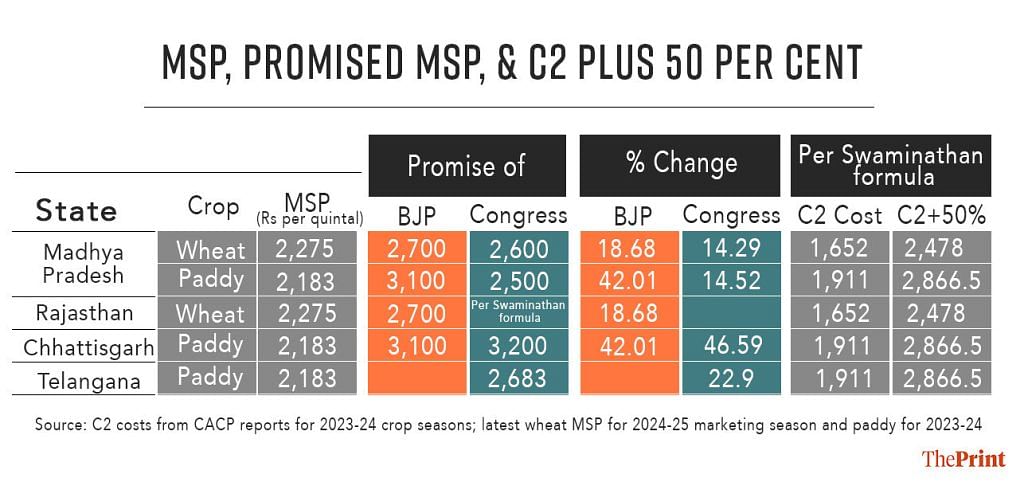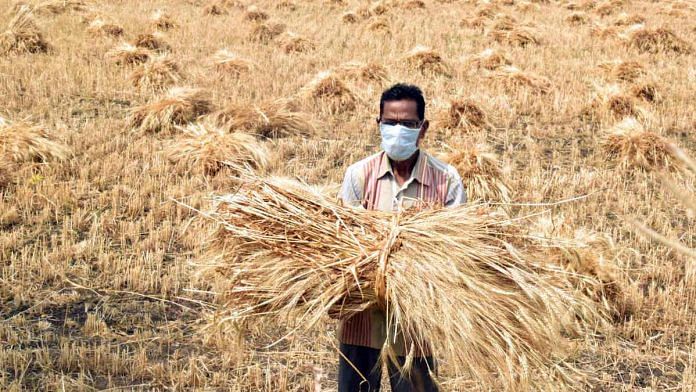Now that the assembly elections are over, it is time to look at the promises made to farmers by the political parties that will form the government in four states. The November 2023 elections in Chhattisgarh, Madhya Pradesh, Rajasthan, and Telangana have delivered to farmers what the yearlong farmers’ agitation of 2020-21 could not.
Except for paddy in Telangana, the farmers of these states are now assured of realising Minimum Support Price (MSP) in line with the Swaminathan formula, also known as C2 + 50 per cent. This formula recommends setting the MSP for crops at least 50 per cent above the comprehensive cost of producing a crop (C2) to ensure fair income for farmers.
Frequent elections are therefore welcome!
The following table shows the promises and what they will mean in different states.

For the calculations above, the C2 costs of paddy and wheat are all-India averages taken from Commission for Agricultural Costs and Prices (CACP) reports for the 2023-24 crop seasons. The MSP for wheat is for the 2024-25 rabi marketing season (RMS). For paddy, the latest MSP is for the 2023-24 kharif marketing season (KMS).
Also Read: Inertia or economics? Why Punjab’s farmers can’t move beyond rice and wheat
Chhattisgarh
Chhattisgarh follows a decentralised procurement system. Rice milled from procured paddy is distributed under the public distribution system and any surplus is handed over to the Food Corporation of India for transportation to other states.
The outgoing Congress government had been giving a bonus of Rs 600 per quintal for paddy procured by state agencies since coming to power in 2018. In its 2023 election manifesto, the party promised to pay Rs 3,200 per quintal for paddy. It also promised to waive farm loans in the state. Not learning anything from the fiscal strain caused by free power in Punjab and Telangana, the manifesto further promised free electricity up to 5 horsepower (HP) at half the rate up to 10 HP.
The BJP’s manifesto for Chhattisgarh almost matched the Congress, promising to procure paddy at Rs 3,100 per quintal. Not only that, it also promised to pay an arrear bonus of Rs 300 per quintal of paddy for 2016-17 and 2017-18, for 2016-17 and 2017-18, the years in which it was in power in the state.
There are significant financial implications. Under the proposed MSP, the new BJP government will have to pay Rs 91.70 crore more per lakh tonne of paddy. In 2022-23, Chhattisgarh procured 87.53 lakh tonnes of paddy. Assuming that the same quantity of paddy is procured in the 2023-24 KMS, the cost comes to Rs 8,026.50 crore.
Rajasthan
In Rajasthan, the Congress manifesto promised to enact a law to ensure MSP in accordance with the recommendation of the Swaminathan Commission. It also pledged interest-free loans up to Rs 2 lakh to all farmers from cooperative banks.
The Union government offers a 2 per cent interest subvention on short-term crop loans up to Rs 3 lakh, bringing the interest rate down from the benchmark rate of 9 per cent to 7 per cent. An additional 3 per cent concession is also available to farmers who make prompt repayments per the schedule. Thus, the effective rate of interest is 4 per cent per annum.
The BJP’s manifesto for Rajasthan promised an additional Rs 6,000 per year as minimum income support under PM Kisan Samman Nidhi. The Union government is already paying Rs 6,000 annually under this scheme, which means that the total amount payable to farmers in Rajasthan would be Rs 12,000 per year. The manifesto further committed to increasing the wheat MSP to Rs 2,700, with a bonus of Rs 425 per quintal.
With the new MSP, the Rajasthan government will have to pay an additional Rs 42.50 crore per lakh tonnes. In the 2022-23 and 2023-24 rabi marketing seasons, adverse weather led to Rajasthan procuring only 10,000 tonnes and 4.38 lakh tonnes of wheat, respectively. But in the 2021-22 RMS, the state procured 23.40 lakh tonnes. If the same quantity is procured in the 2024-25 RMS, the extra burden on the state comes to Rs 994.50 crore.
It must be mentioned that different varieties of millets, or nutri-cereals (Shree Anna), have been promoted by the government repeatedly as priority crops, but the BJP manifesto has not promised any additional incentive. It has only assured that MSP will be given on jowar and bajra. So, the farmers, growing these crops mostly on rain-fed lands, will continue to be at the mercy of the market.
Another matter of great concern is that there is no promise of any bonus for the oilseed crop of mustard, grown on a large scale in Rajasthan. In recent years, mustard farmers in the state have not been able to even realise MSP. One hopes that the state’s new BJP government will prioritise nutri-cereals and oilseeds as much as it has promised for wheat in its manifesto.
Madhya Pradesh
The BJP manifesto promised an additional Rs 12,000 to farmers under the PM Kisan Samman Nidhi scheme. The farmers were also assured Rs 2,700 and Rs 3,100 per quintal of wheat and paddy respectively.
Over the last 15 years, Madhya Pradesh has been extremely successful in increasing its wheat production. Procurement in the last two of years has been low due to excessive heat, but in 2020-21 and 2021-22, the state procured 129.42 lakh tonnes and 128.16 lakh tonnes of wheat, respectively.
To fulfil its manifesto promise, the BJP government of Madhya Pradesh will have to incur an extra expenditure of Rs 5,525 crore if it procures 130 lakh tonnes of wheat from the current rabi crop (at Rs 42.50 crore per lakh tonne). Similarly, if it procures 46.3 lakh tonnes of paddy, as it did in the 2022-23 kharif marketing season, Madhya Pradesh will be required to pay an additional Rs 4,245.71 crore (at Rs 91.7 crore per lakh tonne of paddy).
In the last decade, MP has diversified to various horticultural crops, and is also a top producer of soybean and pulses. I hope that the bonus for wheat farmers will also be matched for other crops. Otherwise, there is a real possibility that farmers will be more inclined to grow wheat rather than diversify into pulses or oilseeds like soybean or mustard.
Telangana
The Congress has promised to pay Rs 2,683 per quintal for paddy, which is Rs 500 more than the MSP. It has also promised to continue the previous government’s free electricity scheme for the agriculture sector. Due to the Kaleshwaram lift irrigation project, farmers have increased areas under paddy cultivation. But the mills in the state produce parboiled rice, for which there is little demand within Telangana. The FCI is also reluctant to take it due to excessive buildup of its stock. The Congress government’s differences with the Centre over paddy procurement are likely to become even more acute. The incentive of Rs 500 per quintal for paddy may encourage even more farmers to grow it rather than pulses or other crops.
In the 2022-23 KMS, Telangana procured 131.86 lakh tonnes of paddy. The state now will have to pay an additional Rs 6,593 crore to paddy farmers for the same quantity (at Rs 50 crore per lakh tonne).
The Congress also promised to increase the amount of direct benefit transfer (DBT) under the Rythu Bandhu scheme from Rs 10,000 to Rs 15,000 per acre. It committed to extending this not only to landowners but also tenants, as a part of its ‘Rythu Bharosa’ guarantee. This direct income support scheme has been criticised for favouring large landowners, including absentees and NRIs.
Also Read: Poultry and chicken keep food inflation low. Time India’s policymakers promoted it
Going forward
As we move closer to the general elections in April 2024, there is a strong possibility of further incentives for agriculture and allied sectors.
Whether we like it or not, direct income support has already arrived, although not for every Indian yet. At the moment, the idea of diversification from paddy has gone for a toss. Is it feasible that farmers of Punjab, Haryana, and Uttar Pradesh will not have the same expectation?
It is hoped that political parties will announce crop-neutral incentives so that the much-discussed and acutely needed diversification from wheat and paddy is actually incentivised.
The author is a former Union agriculture secretary. Views are personal.
(Edited by Asavari Singh)



